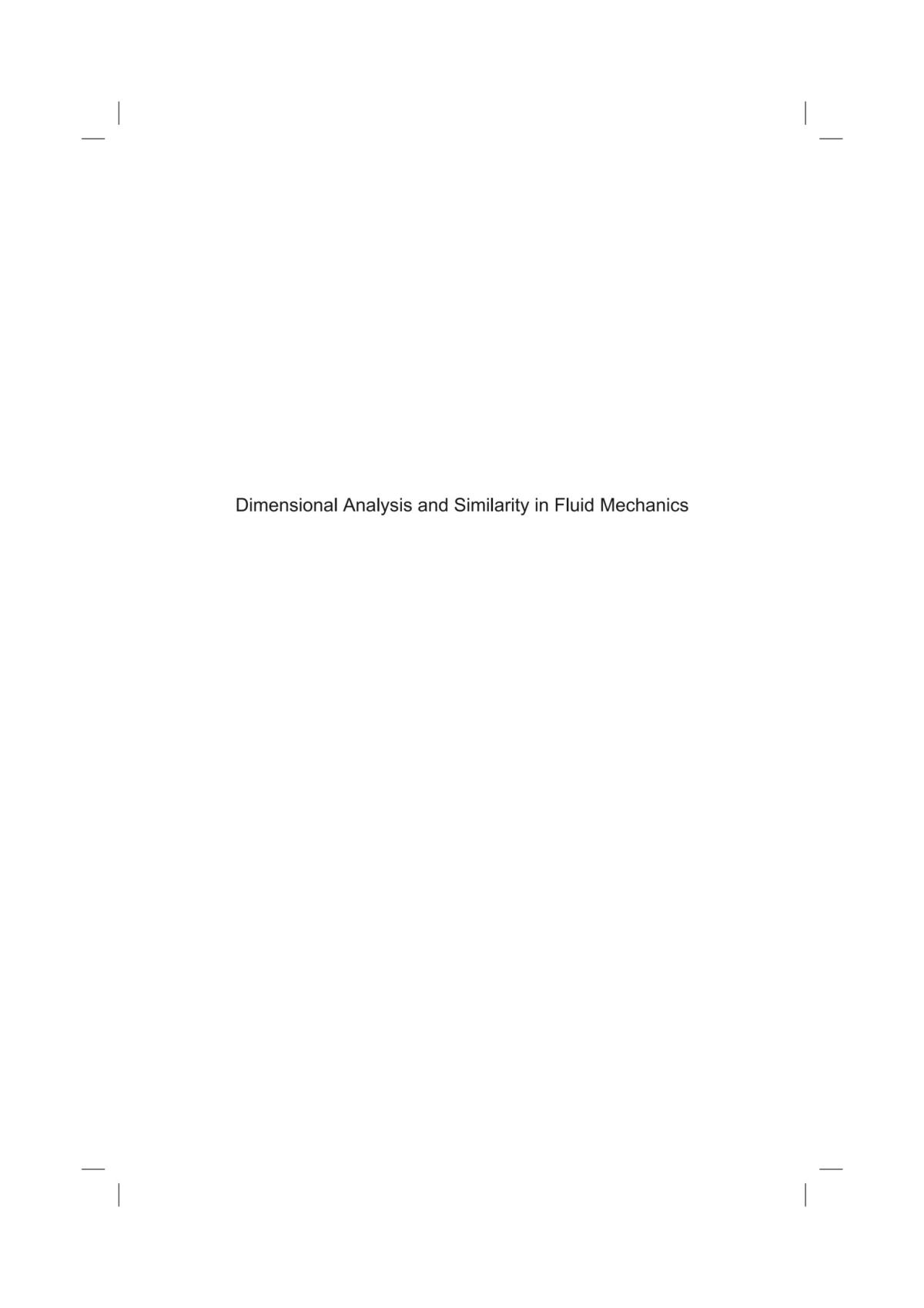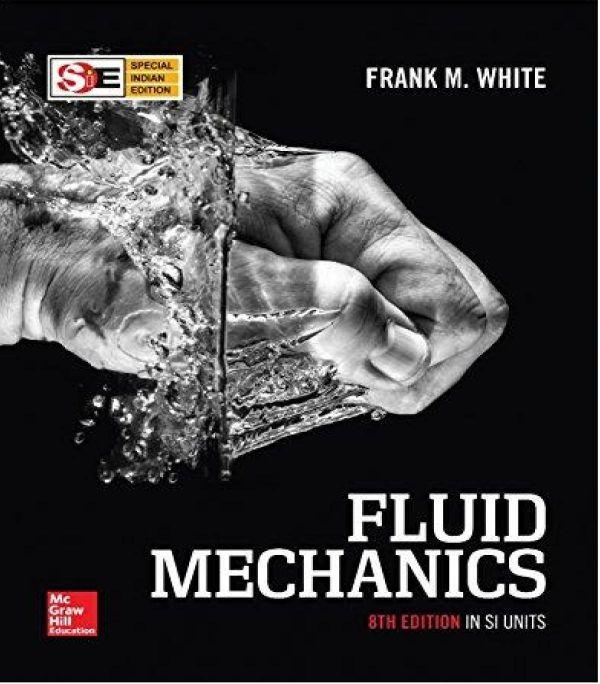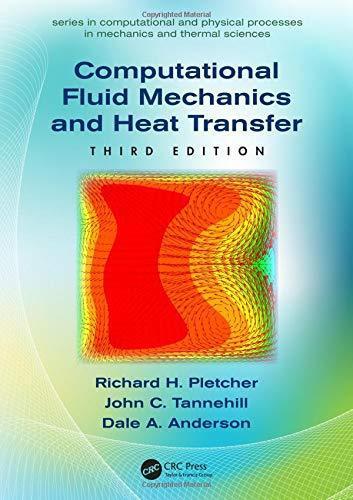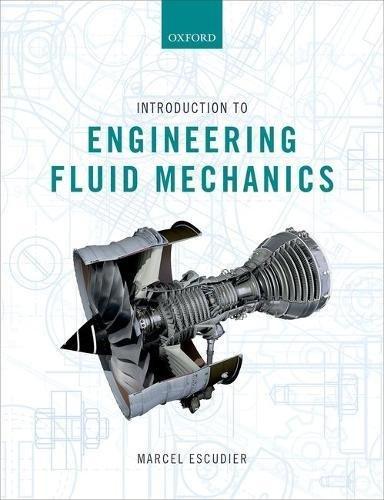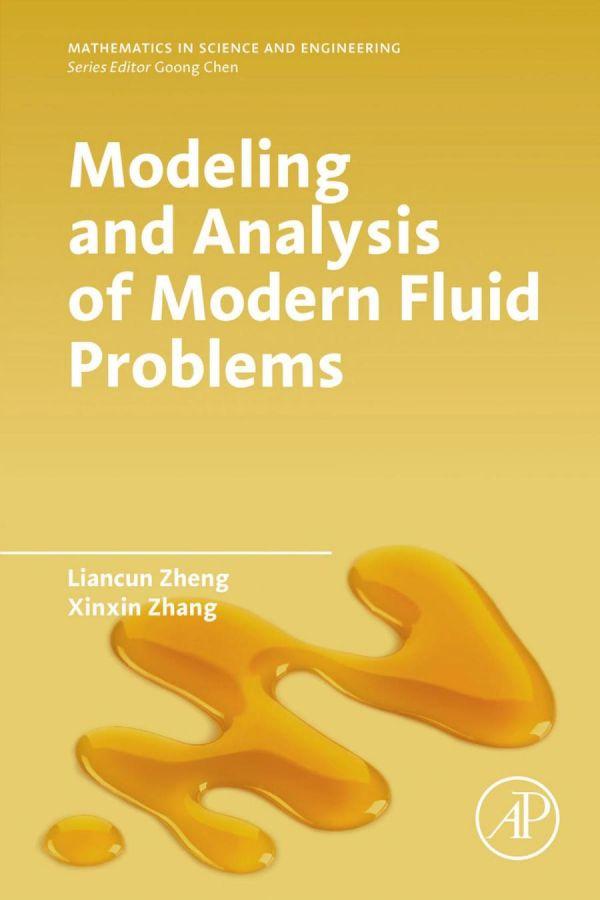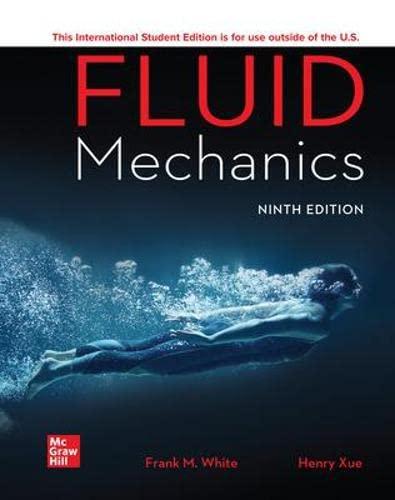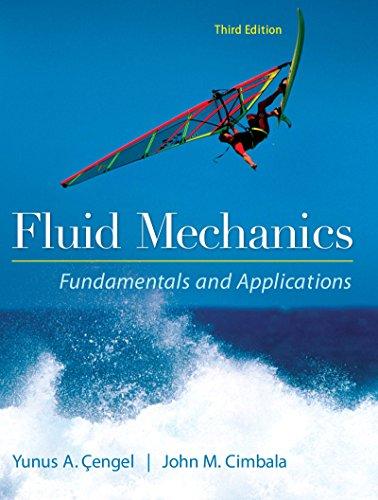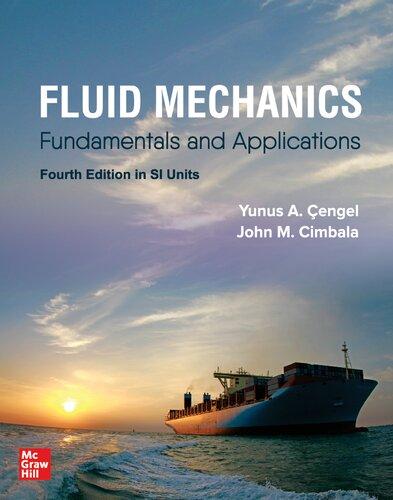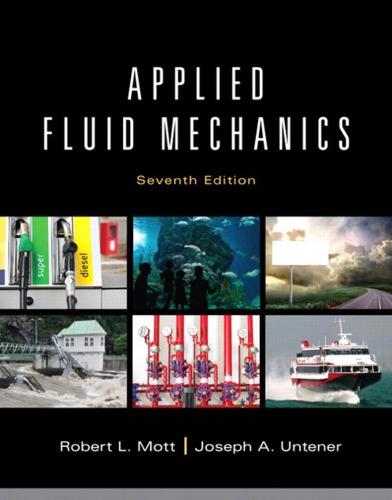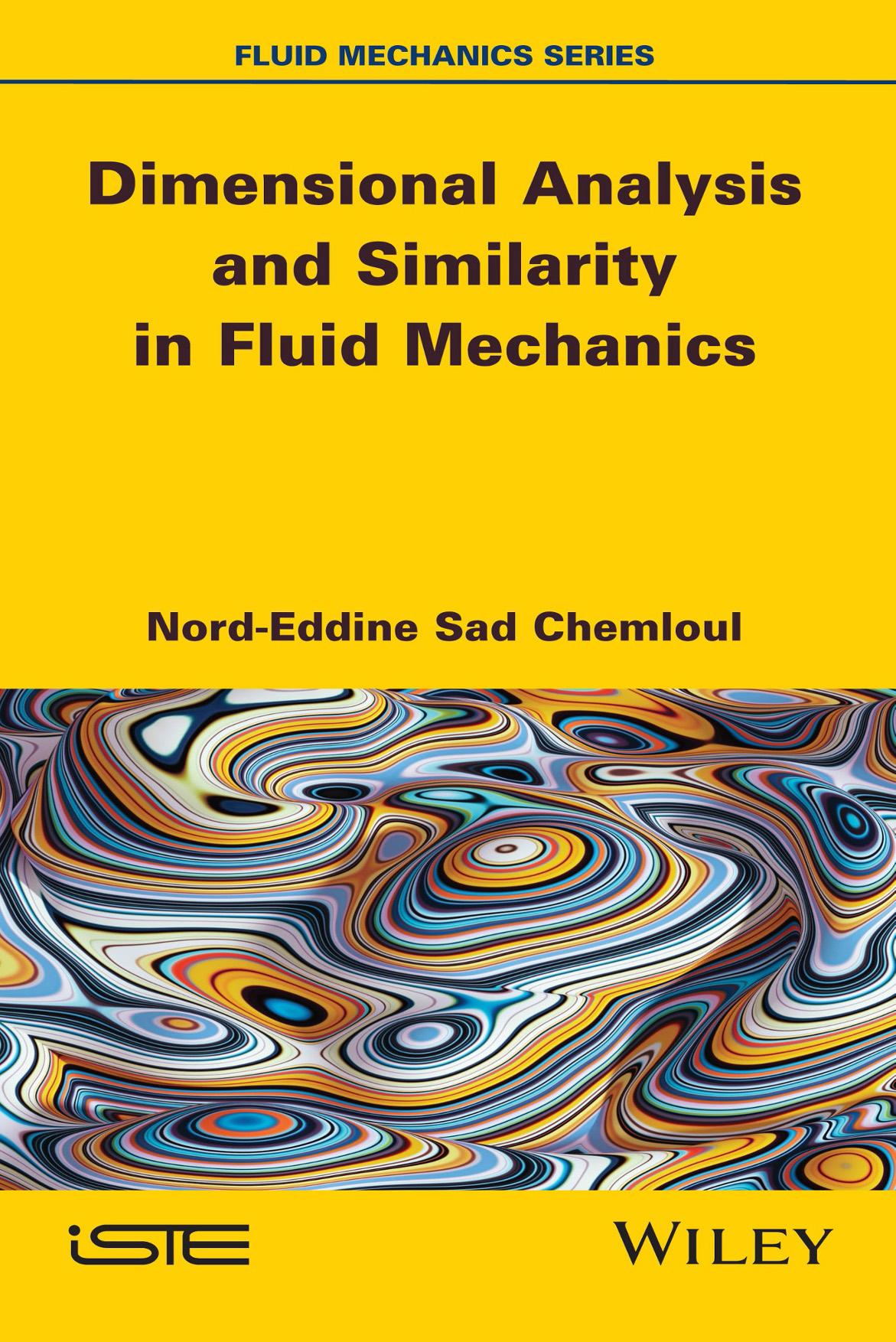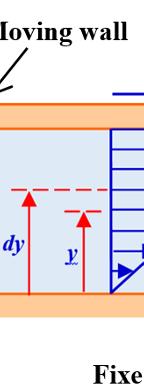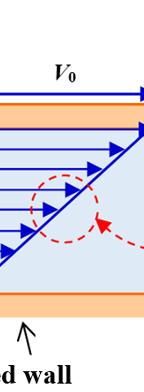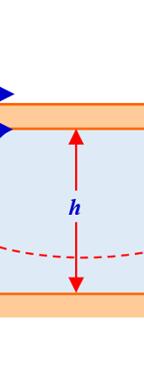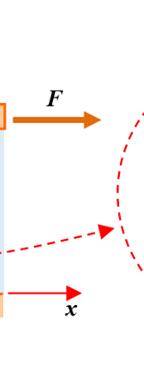Dimensional Analysis and Similarity in Fluid Mechanics 1st Edition
Nord-Eddine Sad Chemloul (Author)
Visit to download the full and correct content document: https://ebookmass.com/product/dimensional-analysis-and-similarity-in-fluid-mechanic s-1st-edition-nord-eddine-sad-chemloul-author/
More products digital (pdf, epub, mobi) instant download maybe you interests ...
Fluid Mechanics, 8 Ed 8th Edition White
https://ebookmass.com/product/fluid-mechanics-8-ed-8th-editionwhite/
Computational Fluid Mechanics and Heat Transfer (Series in Physical
https://ebookmass.com/product/computational-fluid-mechanics-andheat-transfer-series-in-physical/
Introduction to Engineering Fluid Mechanics 1st Edition
Marcel Escudier
https://ebookmass.com/product/introduction-to-engineering-fluidmechanics-1st-edition-marcel-escudier/
Modeling and analysis of modern fluid problems Zhang
https://ebookmass.com/product/modeling-and-analysis-of-modernfluid-problems-zhang/
Fluid Mechanics (9th Edition) Frank M. White
https://ebookmass.com/product/fluid-mechanics-9th-edition-frankm-white/
Free-surface flow: environmental fluid mechanics
Katopodes
https://ebookmass.com/product/free-surface-flow-environmentalfluid-mechanics-katopodes/
Fluid Mechanics Fundamentals and Applications – Ebook
PDF Version
https://ebookmass.com/product/fluid-mechanics-fundamentals-andapplications-ebook-pdf-version/
Fluid Mechanics : fundamentals and applications 4 in SI units. Edition Yunus A. Çengel
https://ebookmass.com/product/fluid-mechanics-fundamentals-andapplications-4-in-si-units-edition-yunus-a-cengel/
Applied Fluid Mechanics 7th Edition Robert L. Mott
https://ebookmass.com/product/applied-fluid-mechanics-7thedition-robert-l-mott/
Dimensional Analysis and Similarity in Fluid Mechanics
Series Editor
Roger Prud’homme
Dimensional Analysis and Similarity in Fluid Mechanics
Nord-Eddine Sad Chemloul
First published 2020 in Great Britain and the United States by ISTE Ltd and John Wiley & Sons, Inc.
Apart from any fair dealing for the purposes of research or private study, or criticism or review, as permitted under the Copyright, Designs and Patents Act 1988, this publication may only be reproduced, stored or transmitted, in any form or by any means, with the prior permission in writing of the publishers, or in the case of reprographic reproduction in accordance with the terms and licenses issued by the CLA. Enquiries concerning reproduction outside these terms should be sent to the publishers at the undermentioned address:
ISTE Ltd
John Wiley & Sons, Inc.
27-37 St George’s Road 111 River Street London SW19 4EU Hoboken, NJ 07030
UK USA
www.iste.co.uk
www.wiley.com
© ISTE Ltd 2020
The rights of Nord-Eddine Sad Chemloul to be identified as the author of this work have been asserted by him in accordance with the Copyright, Designs and Patents Act 1988.
Library of Congress Control Number: 2020940665
British Library Cataloguing-in-Publication Data
A CIP record for this book is available from the British Library ISBN 978-1-78630-596-1
2.4.3.
2.5.
2.5.5.
2.5.8.
2.6. Exercises:
2.6.1.
2.6.2.
2.6.3.
2.6.5.
2.6.6.
2.6.7.
2.6.8.
2.6.9.
2.6.10. Exercise 22: capillary tube
2.6.11. Exercise 23: deformation of a bubble
2.6.12. Exercise 24: laminar dynamic boundary layer on a flat plate ....................................
2.6.13. Exercise 25: power of a stirrer
Chapter 3. Similarity of Flows
3.1. Definition and principle of similarity
3.1.1. Geometric similarity
3.1.2. Kinematic similarity
3.1.3.
3.1.4. Similarity conditions for viscous, incompressible, non-heavy fluids (Reynolds similarity) .....................
3.1.5. Similarity conditions for non-viscous, incompressible, heavy fluids (Reech-Froude similarity) .....................
3.1.6. Similarity requirements for non-viscous, non-compressible, heavy fluids .....................................
3.1.7. Conditions of similarity of turbulent
3.1.8.
3.2. Exercises: similarity of flows
3.2.1. Exercise 1: similarity between ships
3.2.2. Exercise 2: similarity of centrifugal pumps...............
3.2.3. Exercise 3: volumetric pumps with small dimensions
3.2.4. Exercise 4: characteristics of a centrifugal pump
3.2.5. Exercise 5: test of an automobile in a wind tunnel ..........
3.2.6. Exercise 6: power ratios (p model / p prototype) of a pump
3.2.7. Exercise 7: flow in a pipe .........................
3.2.8. Exercise 8: viscous force on a rotating disk ..............
3.2.9. Exercise 9: development study of a hydroelectric gallery ......
3.2.10. Exercise 10: movement of solid matter by a water current .....
3.2.11. Exercise 11: a tapered body .......................
3.2.12. Exercise 12: model of a seaplane ....................
3.2.13. Exercise 13: tide study ..........................
3.2.14. Exercise 14: transient gas flow .....................
3.2.15. Exercise 15: model of a torpedo ....................
3.2.16. Exercise 16: movement of a ball in a fluid ..............
3.2.17. Exercise 17: similarity of the movement of an airship .......
3.2.18. Exercise 18: resistance to the movement of a ship ..........
3.2.19. Exercise 19: mixing tank .........................
3.2.20. Exercise 20: friction on a prototype probe ..............
Foreword
It has been my great pleasure to read this book, a series of exercises and a course review, written by Nord-Eddine Sad Chemloul.
The book addresses dimensional analysis and similarity, tools for solving specific problems in fluid mechanics, and is intended for students of mechanical engineering, civil engineering, maritime engineering, and other similar fields.
The book’s author has taught this subject for over 25 years and has acquired a great deal of experience, allowing him to perfect his course over the years.
The book is firmly structured and well written, making it an easy read. It is divided into three chapters. The first chapter concerns the calculation of dimensions, the verification of the homogeneity of relationships, and the conversion of units. The second chapter introduces the homogeneity method (or Rayleigh method) and the Vaschy-Buckingham method (also known as the π method), which are used in dimensional analysis. The third chapter provides a study of the comparison of fluid flows using similarity.
The book’s numerous exercises, the product of the numerous works and tests prepared by author, are accompanied by detailed and thoroughly commented corrections. This book is also intended for educators.
x Dimensional Analysis and Similarity in Fluid Mechanics
I highly recommend it for students, since it provides them with the essential elements of dimensional analysis and similarity as applied to fluid mechanics.
Driss NEHARI Professor
at the University Center of Ain Temouchent, Algeria
Preface
The theories of fluid mechanics can at times be quite complicated. To better understand them, it is necessary to use exercises to apply them.
The three chapters that make up this book begin with a simple review of the essential knowledge, supplemented by examples.
Fifty exercises are worked out and include commentary. They cover almost all areas of fluid mechanics: flow through orifices, dynamic boundary layers, the behaviors of fluids on solid faces, etc.
These exercises range from the simplest, on the more pedagogical side, to the most difficult, on the practical side. They are intended for all students seeking to familiarize themselves with the discipline of fluid mechanics, in the field of technological sciences, science, and physics.
We would be happy to hear any critiques and suggestions that may be made regarding the level, presentation, and choice of exercises given in this book. We would like to clarify that the choice of exercises has been made with the hope of achieving a compromise between the general education and training of students and the practical implementation of the knowledge they obtain.
Nord-Eddine SAD CHEMLOUL
July 2020
Introduction
The analytical methods (or models) that are used in solving the problems of fluid mechanics are not always satisfactory (as they do not give good results) in practice. This is because it is necessary to use simplifications or detailed and onerous analyses.
The alternative to this is to call upon past experience and deduce correlations applicable to all cases of the same type of problem. In many cases, the experimental conditions in the laboratory are not the same as those in real life (for example, the dimensions of the centrifugal pump model and its prototype, or the different fluids), and in these cases, dimensional analysis is used. This analysis allows for dimensionless correlations of dimensionless numbers to be obtained, which are generally applicable to all practical cases. In other words, these dimensionless correlations can be applied under dynamic conditions, similar to those in which they were established by using, for instance, a different fluid.
Dimensional analysis is a practical method for verifying homogeneity (the method devised by John William Strutt Rayleigh) of a physical formula through its dimensional equations. This is achieved by subdividing the physical quantities included in the formula into a product of fundamental or basic values: length, duration, mass, electrical intensity, etc., each of which are irreducible with respect to all others.
Dimensional analysis is based on the principle that only the values of the same dimension can be compared or added; a length may be added to another length, but it cannot be said to be greater than, or less than, a measurement of mass. A physical law cannot change, except in the
numerical values of its constants when expressed in other units. This is mathematically demonstrated by the theorem of Aimé Vaschy and Edgar Buckingham.
In basic physics, dimensional analysis makes it possible to obtain the form of an equation from assumptions about the quantities that govern the state of a physical system. Then, the hypotheses can be validated by a complete theory. For applied sciences, dimensional analysis is the basis for modeling through replicas and the study of effects of scale.
Similarity in fluid mechanics plays a very important role in the design and construction of large-scale and high-cost installations, and structures in many fields such as aeronautics, hydraulics, chemical engineering, and others. Thus, it is important to have the necessary tools to accurately define all characteristics of the work that would allow us to achieve the desired outcomes.
Therefore, we must attempt to represent the true operating conditions of the work using a model. The accuracy of the results obtained will depend on the level of quality of this representation. However, the problems addressed in fluid mechanics show that it is very difficult to correctly translate the characteristics of a given flow at any time and at any point, especially when this flow is turbulent. This means it is impossible to correctly write about and address the basic equations, because the model is only an approximate representation of the actual functionality. In this sense, two possibilities have been provided for: solving simplified equations mathematically, or the conducting of a laboratory study of a concrete representation of the work. These two methods are in fact complementary, and it is always in our best interest to use them in conjunction with each other.
In this book, only the second method is used. This method involves creating a physical model of the proposed installation or structure, which defines the similarity. The dimensions of the model are generally smaller than those of the work, meaning that the model is reduced.
Homogeneity of Relationships and Conversion of Units
1.1. Introduction
The creation of a system of units requires the definition of basic units, their values, and the units derived from them. In mechanics, the units used are length, mass and time, but other options are possible as well, such as length and time, force and time, or mass, speed and time.
The first general conference on weights and measures was held in 1889 at the headquarters of the BPIM (Bureau international des poids et mesures or International Office of Weights and Measures), at the Breteuil pavilion in Sèvres (in the suburbs of Paris). In this conference, new international prototypes of the meter and kilogram were officially adopted and filed with the Office.
In 1960, the 11th General Conference of Weights and Measures established the International System (SI), in which the rules for prefixes, derived units and other indications were established. The SI is based on a choice of seven well-defined base units that the convention considered dimensionally independent: the meter, the kilogram, the second, the ampere, the kelvin, the mole and the candela. Derived units are formed by combining the base units according to the algebraic relationships connecting the corresponding quantities. The names and symbols of some of these units may be replaced by special names and symbols, which may be used to express the names and symbols of other derived units.
In November 2018, the International System of units later underwent a significant revision at the 26th General Conference of weights and measures, the culmination of nearly 250 years of consideration given to finding the best way to define a system of units of measurement that would best reflect the natural world.
The General Conference of weights and measures, established at the end of the 19th Century, meets every four to six years to discuss, and possibly modify, the SI, standardizing the units on a global scale. The new changes were applied as of May 20, 2019.
M Time Second s T
Intensity of electric current Ampere A I
Thermodynamic temperature Kelvin K Q
Quantity of matter Mole mol N
Intensity of light Candela cd J
1.1. Basic SI units
1.2. Definitions of the basic SI units
1.2.1. Definition of the meter as adopted in 1983
The “meter” is the “length” of the distance light travels in a vacuum for a period of 1/299792458ths of a second. From this, it can be determined that the speed of light in a vacuum is exactly: c0 = 299,792,458 m/s.
1.2.2. Definition of the kilogram
The “kilogram” is the unit of mass. It is equal to the mass of the international prototype of the kilogram. The term “weight” refers to a quantity that is of the same nature as a force; the weight of a body is the
Table
product of the mass of that body multiplied by the acceleration due to gravity. Specifically, the normal weight of a body is the product of the mass of this body multiplied by the normal acceleration from gravity. The number adopted by the International Service of Weights and Measures for the value of normal acceleration from gravity is 980.665 m/s2.
The kilogram is currently defined as the mass of an Iridium platinum cylinder (90% platinum and 10% iridium) 39 mm in diameter and 39 mm high declared the SI unit of mass in 1889 by the BIPM. This unit of measurement is the last SI unit to be defined using a man-made physical standard. It is stored under three sealed glass bells, and it is only removed from this covering for calibrations (an operation that has taken place only three times since its creation). As of May 20, 2019, the kilogram has been defined on the basis of Planck’s constant (h)1 from quantum physics, measured on the Kibble2,3 scale at 6.626069934 × 10-34 kg.m2.s-1.
1.2.3. Definition of the second adopted in 1967
The “second” has the duration of 9,192,631,770 periods of radiation from the transition between the two hyperfine levels of the base state of a cesium 133 atom. As a result, the frequency of the hyperfine transition of the base state of the cesium atom is equal to 9,192,631,770 hertz (Hz). Thus, we obtain exactly ν (hfs4 Cs) = 9,192,631,770 Hz. At its 1997 session, the International Committee on Weights and Measures confirmed that this definition refers to a cesium atom at rest, at a temperature of 0 K (Kelvin4).
1 Max Planck, born Max Karl Ernst Ludwig Plank, on April 23, 1858, in Kiel, in the Duchy of Schleswig (Germany), living until October 4, 1947, was a physicist. Planck’s constant h plays a central role in quantum mechanics: it links the energy of a photon to a photon’s frequency.
2 The scale created by Bryan Peter Kibble is a device that allows for the conversion, with nine significant figures, of mechanical power into electrical power and vice versa Kibble, born on August 10, 1938, in Letcombe Regis (England), who lived until April 28, 2016, was a physicist and an expert in metrology
3 Hyperfine splitting of cesium.
4 William Thomson, better known as Lord Kelvin, born on June 26, 1824, in Belfast (Northern Ireland), who lived until December 17, 1907, was a physicist best known for his works on thermodynamics.
1.2.4.
Definition of the ampere adopted in 1948
The “ampere”5 is the intensity of a constant current that is produced between two parallel conductors following straight lines of infinite length and of a negligible circular cross-section placed at a distance of 1 meter from each other in a vacuum between these conductors, a force equal to 2.10-7 newtons6 per meter of length. As a result, the magnetic constant, also known as vacuum permeability, is equal to exactly 4π.10-7 Henrys7 per meter (4π.10-7 H/m). The Ampere is linked to the elementary charge (e), the electric charge of a proton. The mole, the unit for quantities of matter, used mainly in chemistry, is defined directly through the determining of Avogadro’s number (AN)8
1.2.5. Definition of Kelvin adopted in 1967
The Kelvin, a unit of thermodynamic temperature, is the fraction (1/273.16) of the thermodynamic temperature of the triple point of water. As a result, the thermodynamic temperature of the triple point of water is exactly 273.16 Kelvin (273.16 K). Other changes that were made: the Kelvin scale, measured based on water, was redefined based on the Boltzmann9 constant (k), related to the measurement of the thermal agitation of the fundamental constituents of a body.
5 André-Marie Ampère, born in Lyon (France) on January 20, 1775, and who lived until June 10, 1836, was a mathematician, physicist, chemist and philosopher. He contributed to the development of mathematics by introducing it into physics. He made important discoveries in the field of electromagnetism.
6 Isaac Newton, born on January 4, 1643, in Woolsthorpe (England), and who lived until March 31, 1727, was a philosopher, mathematician, physicist, alchemist, astronomer and theologian. His book, Philosophiæ Naturalis Principia Mathematica, published in 1687, is considered one of the greatest works in the history of science.
7 Joseph Henry, born on December 17, 1797, in Albany (New York) and who lived until May 13, 1878, was a physicist who discovered self-induction and the principle of electromagnetic induction from induced currents.
8 Lorenzo Romano Amedeo Carlo Avogadro, Count of Quaregna and Cerreto, known as Amedeo Avogadro, was a physician and chemist, born in Turin (Italy) on August 9, 1776, and who lived until July 9, 1856.
9 Ludwig Eduard Boltzmann, born on February 20, 1844, in Vienna (Austria) and who lived until September 5, 1906, was a physician and philosopher, considered to be the father of statistical physics, and an avid proponent of the existence of atoms.
1.2.6.
Definition of a mole
The mole10 is the amount of matter in a system containing as many indivisible entities as there are atoms in 0.012 kilograms of carbon 12; the symbol for this unit is “mol”. When using the mole, the individual entities must be specified, and may be atoms, molecules, ions, electrons, other particles, or specified groups of such particles. In this definition, it is understood that this refers to unlinked carbon 12 atoms, at rest, and in their base state. As a result, the molar mass of carbon 12 is equal to 0.012 kilograms per mole (0.012 g/mol).
1.2.7.
Definition of the candela adopted in 1979
The Candela11 measures the luminous intensity in a given direction of a source that emits energy in monochromatic rays in that direction; it is 1/6, 831ths of a watt12 per steradian13. From this, it can be determined that the spectral luminous efficiency of monochromatic rays of a frequency of 540x1012 hertz is equal to 683 lumens14 per watt (683 lm/W = 683 Sr/W).
1.3. Additional quantities and SI derived quantities
Table 1.2 gives the two additional quantities that have been introduced to ensure the coherence of the system.
Table 1.3 shows the derived quantities in the International System generally used in fluid mechanics and heat transfer.
10 The name of the unit of quantities of matter, the mole, originates from the abbreviation of the German word Molekül: “Mole” (with a capital “m”, and followed by a rapidly abandoned point) was proposed in 1893 by chemist Wilhem Ostwald to indicate “the weight in grams numerically equal to the molecular weight of a given substance”. The term “Mole” first appeared in 1902 as the English equivalent of the German term.
11 The candela (abbreviated as “cd”, from the Latin word meaning “candle”) is one of the seven basic SI units.
12 James Watt, born on January 19, 1736, in Greenock (Scotland) and who lived until August 25, 1819, in Heathfield Hall (in his house in Handsworth, England), was an engineer whose improvements to the steam engine were one of the key advances in the industrial revolution.
13 The Steradian (symbol: “sr”) is the SI derived unit for the measurement of solid angles.
14 The lumen (from the Latin word for “light”) is the SI derived unit for luminous flux.
Table 1.2. SI derived quantities
Table 1.3. Some of the SI derived quantities used in fluid mechanics and
1.4. Rules for the use of units
1.4.1. Unit name
All names of units, even those derived from the names of noteworthy figures, are considered as common nouns: pascal, newton, hertz, volt15, ampere, henry, weber16, watt, joule, pascal17, newton, hertz, coulomb18, etc.
The initials are written in lowercase, and are given in plural if they apply to a number greater than or equal to 2. For example: 1.9 volt, 3 amps, 1.4 newton, 5 watts, 3 henrys, etc.
The names of the units derived from the names of notable scientific figures are masculine in gender (one joule, one Ampere, one henry).
No qualifiers should be added to a unit name (the term “linear meter” is not used).
When one quantity is the product of two others, and neither of them is a quotient, the name of the unit is obtained by joining the two corresponding units with a hyphen (making sure not to use a forward slash, which indicates a quotient). For example, electrical energy that is the product of power and time can be expressed as a “watt-hour”. In the case of very common units, the two names can be combined: a “watthour” or a watt-hour. The plural mark is to be added to the two component names in the case of a hyphen and to the last one in the case of contiguous nouns: watt-hours or watthours, meters-newtons.
When one quantity is the quotient of two others which are not quotients themselves, the name is obtained by placing the word “per” (and not the
15 The name “Volt” was created in tribute to Alessandro Volta, an Italian inventor who invented the voltaic pile (battery) in 1800.
16 Wilhelm Eduard Weber, born on October 24, 1804, in Wittemberg (Germany) and who lived until June 23, 1891, was a physicist who developed an original theory of electromagnetic interaction.
17 Blaise Pascal, born on June 19, 1623, in Clermont-Ferrand, and who lived until 1662, was a mathematician, physicist, inventor, philosopher, moral thinker and theologian.
18 Charles-Augustin Coulomb, born on June 14, 1736, in Angoulême, and who lived until August 23, 1806, was an officer, engineer and physicist who is the namesake for the unit for electric charge in SI.
symbol for division) between the units of the dividend and those of the divisor: kilometer per hour, meter per second.
1.4.2. Unit symbols
Following a number, a unit name can be replaced by its symbol: we may write 5 meters or 5 m, but it is necessary to write five meters (and not “five m”).
A unit symbol should not be changed; in particular, it should never be given in plural: 15 kg (and not “15 kgs”) and it should not be followed by a dot, except at the end of a sentence. A symbol must be placed after the numerical results in the case of decimal units: 26.3m (not “26m3”). This rule does not apply to units that are not decimal units: 12hrs, 15m, 30s.
1.4.3.
Compound symbols
In the case of compound units, the symbol is represented by an algebraic expression in which each of the symbols plays the same role as the magnitude defining the equation; thus in the case of a product (vector or scalar) or quotient, the symbol is the product (vector or scalar) or the quotient of the symbols of the compound units. For example, the watt-hour is represented by the symbol (Wh) for the unit of electrical energy.
A velocity, the quotient of length and time, can be expressed with a unit whose symbol is m÷s (horizontal bar) or m/s (forward slash) or (m.s- 1).
Since the moment of a force is numerically equal to the vector product of the intensity of a force and a length, the symbol of the unit of moment can be written (mΛN or N.m). It should be noted that, according to ISO 31, the point between the two symbols should be at the midpoint of the height of the line of text: N.m.
The expression obtained can be transformed by applying the rules of algebra, with electrical resistance being defined by the expression (RS/l) where R is a resistance, S a surface and l a length, and the corresponding unit has the symbol (W.m2/m) or (W.m) after simplification. Positive or negative exponents can also be used in these expressions: density is the quotient of a mass and a volume; the unit uses the symbol (kg/m 3 or kg.m-3).
1.5. Exercises
1.5.1. Exercise 1: calculation of dimensions
1) Write the dimension of force.
2) Write the dimension of energy.
3) Write the dimension of a pressure (force per unit area).
4) Show that a measurement of pressure is one of volumetric energy. Can you find a formula that translates this result?
5) Write the dimension of the expression 2 (/2) Vρ where ρ is a density and V is the velocity of a fluid. Compare with the dimension of a pressure.
6) Write the dimension of gzρ with g as the acceleration from gravity z as the side. What do you conclude from this?
7) Can you give a physical formula that translates questions 4), 5) and 6)?
8) Check the homogeneity of the equation 2 Vgh = , where h is a height. What do you think the result expresses?
9) In the following relationship dV dy τμ = , τ is the shear stress, μ is the dynamic viscosity and dV dy is the speed gradient. Determine the dimension of the dynamic viscosity µ.
1.5.1.1. Solutions
1) The force is given by F mγ = , and its dimension is [ ] [ ] [ ] Fm γ = , with as mass and γ as acceleration.
2) The dimension of a measure of energy E is:
3) The dimension of pressure P is:
4) the dimension of the relationship Energy volume E = v is:
COMMENT 1.1. The dimension of the relationship between energy and volume is that of a pressure. Pressure therefore represents a measure of energy per unit of volume, which represents one of the three forms of the Bernoulli equation expressed in joules per unit of volume. We recall that the Bernoulli equation expresses the conservation of total mechanical energy (kinetic energy + potential energy + pressure energy)
For formulas translating the same result, we can cite the following: the manometric (or effective) pressureat a depth with respect to a free surface subjected to atmospheric pressure (taken as equal to zero) is
With [ ] 3 ML ρ = , [ ] 2 g LT = and [ ] hL = , the dimension of the term Pman ghρ = is: [ ] 12ghMLTρ =
The unit for this is:
We can also give the expression of the amount of work exchanged with a perfect gas.
5) The term has the dimension.
We recall that the dimension of a constant is equal to the unit.
The dimension of the relationship is that of a pressure, and is called dynamic pressure.
6) The dimension of the term g z ρ , with z as the side.
The dimension of the term g z ρ is that of a pressure; it is referred to as potential energy of gravity or static pressure.
7) The relationship that translates questions 4), 5) and 6) is the total conservation of mechanical energy or Daniel Bernoulli’s equation19:
potenial energy energy from kinetic energy or of gravity pressure forces dynamic pressure
This relationship represents the total pressure PTotal .
8) The homogeneity of the equation is 2 Vgh = .
The dimension of speed is .
The dimension is .
The equation is therefore dimensionally homogeneous.
9) The dimension of dynamic viscosity is:
19 Daniel Bernoulli, born in Groningen (Netherlands) on February 8, 1700, and who lived until March 17, 1782, was a doctor, physicist and mathematician. He formulated the fundamental theorem of fluid mechanics which bears his name, Bernoulli’s theorem, in his book Hydrodynamica (1738).
And therefore: [] 11 M LT μ =
COMMENT 1.2. From questions 5), 6) and 7), assuming that the side is zero, we obtain the relationship giving the dynamic pressure: 2 2 Totalstatic V PP ρ =− which determines the velocity of the flow, or: 2 PPTotalstatic V ρ =
In practice, the total pressure and the static pressure are measured using a Pitot tube20, or separately using piezometric tubes
In question 8), the relationship is called Torricelli relationship21, and is obtained by applying the Bernoulli equation (with respect to a horizontal reference plane HRP) between the point (1) belonging to the free surface of a liquid contained in a reservoir and the point (2) belonging to an orifice located at a given depth below the free surface (see Figure 1.1), which is:
since the horiz since the reservoir has large dimensions
() ontal references passes through point 2
The orifice is either at the bottom of the container (see Figure 1.1) or on its side on the surface. The drop in pressure is negligible between points (1) and (2). We obtain .
20 Henri Pitot, born in Aramon on May 29, 1695, and who lived until December 27, 1771, was a hydraulic engineer and inventor of the Pitot tube, used to measure the speed of fluids. 21 Evangelista Torricelli, born on October 15, 1608, in Faenza (Italy) and who lived until October 25, 1647, was a physicist and mathematician known in particular for inventing the barometer. 2 Vgh = 2 Vgh =
Analys
is and Similarit
Figu
COMME relation experim
re 1.1. Flow HRP: horizo see NT 1.3. F ship is obt ent” given i
Or a The low moveme Seve fluids of the the the this exp
through an ori ntal reference www.iste.co. or question ained from n Figure 1.2
fluid locate er plane i nt) and mov ral experim different na relationship proportiona relationshi eriment is w
d between tw s set and es at the spe ents were c tures. The re is prop lity factor d p between t ritten as F S F S ∝
ty in Fluid Mech rifice, establish e plane. For a .uk/sadchemlo n 9), relati the experim 2. wo horizonta the upper eed thereb carried out esults of thes
portional to th depends only the different or 0V 0V h F S = hanics
hing of the Tor color version oul/mechanics
rricelli relation of this figure, .zip or N as “movab arated by a h movable (in e fluid to m
ionship ment known al planes sepa plane is m by causing th using differ se experimen
ent geometr nts show that hip ; re of the flui operties inv dV dr μ 0V h nship; Newton’s ble wall height h. uniform ove. ries and t: d; volved in
he relationsh y on the natur physical pr ; τ = 0V k h
the triangle right-an the represen fluid; it is c Fig v 1.5.2. E
Hom p F S repres
mogeneity of Re
relationshi formed by gled triangl proportiona ts dynamic depends m alled the spe
ure 1.2. New ersion of this xercise 2:
V0 and h, an les, which ma lity factor viscosity, w ore on temp ed gradient wton’s experim figure, see w
homogen
1) Ch the osci solid an extensio
2) A dimensi dV dy
eck the ho llation frequ d the spri n with th re the fol onal analysi kr l Δ
mogeneity o uency of a ng stiffness e relationsh lowing rela is to confirm k f
lationships and ngential she ormed by dV ble to write only on the na thermo-phys n on pressu
ents the tan d the one fo kes it possib depends o hich is a t erature tha ent known as ww.iste.co.uk/
eity of rela
Conversion of
ar stress τ = V and dy, are 0V dV hdy = ; ature of the f ical property ure. The rela
f the relatio solid-spring constant. Th ip . tionships v or correct th r F kl=Δ
s the “moving k/sadchemloul/ ationships onship g system, wit he restoring f valid dimen his. 2 f =
Units 15 F S . The e similar fluid and ty of the ationship olor ip resenting ass of the tes to the Make a
wall”. For a co /mechanics.zi repr th the ma orce relat nsionally? M 1 kr m π m F
a) Gm F r = like F is a force, G is a constant expressed in 3 2 m kgs , m is a mass and r is a distance.
b) like P is a pressure, g is the acceleration due to gravity, 1 h and 2 h are heights and F force.
c) , , and represent lengths.
3) Which of these relationships are homogeneous?
a) , ,, with as time, the length and acceleration from gravity.
b) , , with as energy, the amount of motion, the speed of light and the mass.
c)
d)
f) with being the length, the force, spring stiffness constant, the mass, the time and the angle. 12 P ghhFρ =+
e)
1.5.2.1. Solutions
1) Ratio
The dimension of the frequency f is []
and the dimension of the mass is .
The dimension of the spring stiffness constant is therefore:
The ratio has the dimension:
We recall that the dimension of the constant 2π is equal to the unit.
The relationship is therefore homogeneous from the point of view of the dimension.
2) a) The relationship Gm F r = .
The dimension of the force is .
The dimension of G is []
